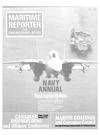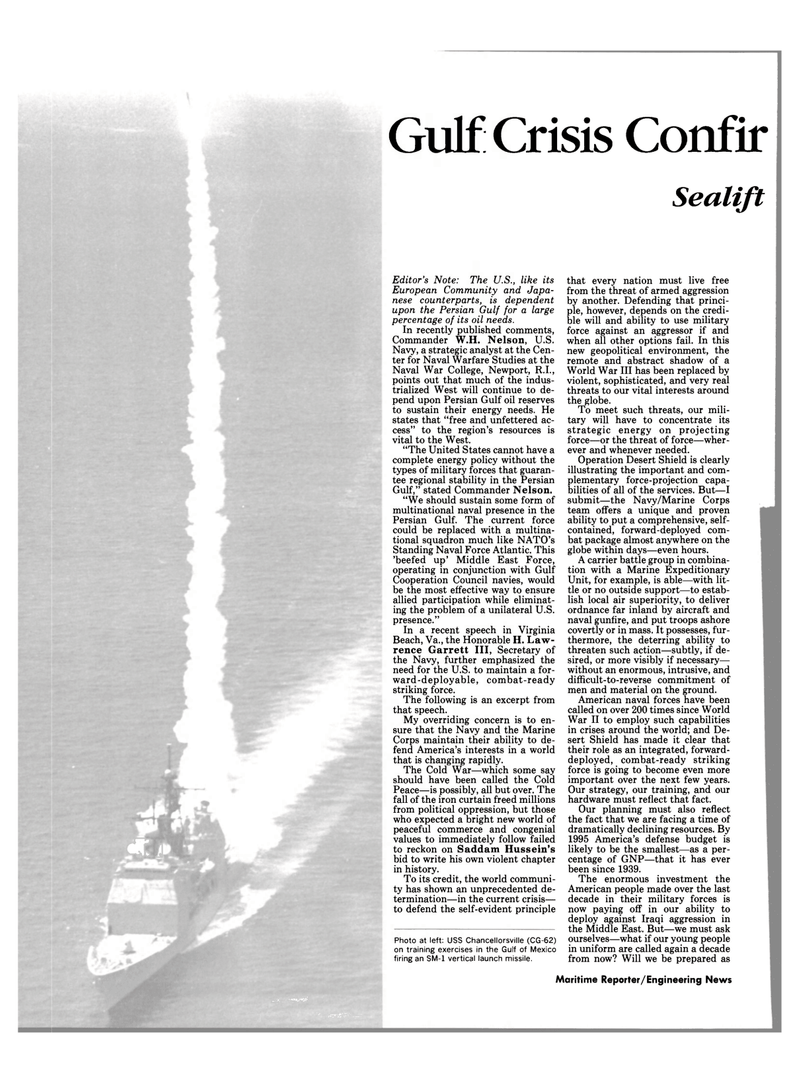
Page 38: of Maritime Reporter Magazine (February 1991)
Read this page in Pdf, Flash or Html5 edition of February 1991 Maritime Reporter Magazine
•K ]
Gulf Crisis Confir
Sealift
Editor's Note: The U.S., like its
European Community and Japa- nese counterparts, is dependent upon the Persian Gulf for a large percentage of its oil needs.
In recently published comments,
Commander W.H. Nelson, U.S.
Navy, a strategic analyst at the Cen- ter for Naval Warfare Studies at the
Naval War College, Newport, R.I., points out that much of the indus- trialized West will continue to de- pend upon Persian Gulf oil reserves to sustain their energy needs. He states that "free and unfettered ac- cess" to the region's resources is vital to the West. "The United States cannot have a complete energy policy without the types of military forces that guaran- tee regional stability in the Persian
Gulf," stated Commander Nelson. "We should sustain some form of multinational naval presence in the
Persian Gulf. The current force could be replaced with a multina- tional squadron much like NATO's
Standing Naval Force Atlantic. This 'beefed up' Middle East Force, operating in conjunction with Gulf
Cooperation Council navies, would be the most effective way to ensure allied participation while eliminat- ing the problem of a unilateral U.S. presence."
In a recent speech in Virginia
Beach, Va., the Honorable H. Law- rence Garrett III, Secretary of the Navy, further emphasized the need for the U.S. to maintain a for- ward-deployable, combat-ready striking force.
The following is an excerpt from that speech.
My overriding concern is to en- sure that the Navy and the Marine
Corps maintain their ability to de- fend America's interests in a world that is changing rapidly.
The Cold War—which some say should have been called the Cold
Peace—is possibly, all but over. The fall of the iron curtain freed millions from political oppression, but those who expected a bright new world of peaceful commerce and congenial values to immediately follow failed to reckon on Saddam Hussein's bid to write his own violent chapter in history.
To its credit, the world communi- ty has shown an unprecedented de- termination—in the current crisis— to defend the self-evident principle
Photo at left: USS Chancellorsville (CG-62) on training exercises in the Gulf of Mexico firing an SM-1 vertical launch missile. that every nation must live free from the threat of armed aggression by another. Defending that princi- ple, however, depends on the credi- ble will and ability to use military force against an aggressor if and when all other options fail. In this new geopolitical environment, the remote and abstract shadow of a
World War III has been replaced by violent, sophisticated, and very real threats to our vital interests around the globe.
To meet such threats, our mili- tary will have to concentrate its strategic energy on projecting force—or the threat of force—wher- ever and whenever needed.
Operation Desert Shield is clearly illustrating the important and com- plementary force-projection capa- bilities of all of the services. But—I submit—the Navy/Marine Corps team offers a unique and proven ability to put a comprehensive, self- contained, forward-deployed com- bat package almost anywhere on the globe within days—even hours.
A carrier battle group in combina- tion with a Marine Expeditionary
Unit, for example, is able—with lit- tle or no outside support—to estab- lish local air superiority, to deliver ordnance far inland by aircraft and naval gunfire, and put troops ashore covertly or in mass. It possesses, fur- thermore, the deterring ability to threaten such action—subtly, if de- sired, or more visibly if necessary— without an enormous, intrusive, and diffkult-to-reverse commitment of men and material on the ground.
American naval forces have been called on over 200 times since World
War II to employ such capabilities in crises around the world; and De- sert Shield has made it clear that their role as an integrated, forward- deployed, combat-ready striking force is going to become even more important over the next few years.
Our strategy, our training, and our hardware must reflect that fact.
Our planning must also reflect the fact that we are facing a time of dramatically declining resources. By 1995 America's defense budget is likely to be the smallest—as a per- centage of GNP—that it has ever been since 1939.
The enormous investment the
American people made over the last decade in their military forces is now paying off in our ability to deploy against Iraqi aggression in the Middle East. But—we must ask ourselves—what if our young people in uniform are called again a decade from now? Will we be prepared as 40 Maritime Reporter/Engineering News , .v; ; - M-
Siw ' • -

 37
37

 39
39
